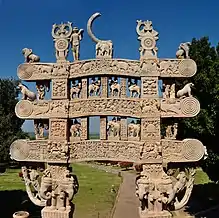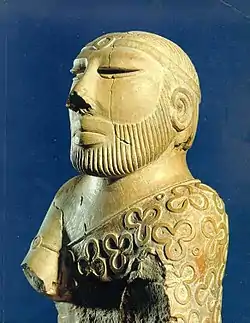Soomra dynasty
The Soomra dynasty was a Rajput kingdom of Sindh, and at times adjacent regions, located in what is now present-day Pakistan. Beginning with the reign of Soomar, the dynasty ruled Sindh, in the northwest part of the Indian subcontinent from 1026 to 1356, and re-established local rule over Sindh after a period of several centuries of Arab rule.[1]
Soomra dynasty | |||||||||
|---|---|---|---|---|---|---|---|---|---|
| 1026–1356 (Continued in exile until 1440 in Umerkot) | |||||||||
| Capital | Thari (in present-day Badin District in Sindh) | ||||||||
| Common languages | Sindhi (native language) Arabic (liturgical language) | ||||||||
| Religion | Shia Ismaili | ||||||||
| Government | Monarchy | ||||||||
| History | |||||||||
• Soomra dynasty begins | 1026 | ||||||||
• Soomra dynasty ends | 1356 (Continued in exile until 1440 in Umerkot) | ||||||||
| |||||||||
Part of a series on the |
|---|
| History of India |
 Satavahana gateway at Sanchi, 1st century CE |
Part of a series on the |
|---|
| History of Pakistan |
 |
| Timeline |
|
History
Genealogy of Soomras
- 949 – 972: Maharaja Siyak II Parmar of Ujjain
- Rao Sidhdhawal Parmar Of Ujjain
- Rao Soomar Parmar of Sindh
(progenitor of Soomra Dynasty in Sindh)
- 1011 – 1026: Khafif I bin Rao Soomar Parmar
Soomra Sardars of Thari Sindh
- 1026 – 1053: Soomar bin Rao Soomar Parmar
- 1053 – 1068: Bhungar I bin Khafif I Soomro
- 1068 – 1092: Dodo I bin Bhungar Soomro
- 1092 – 1098: Zenav Tari Sultana bint Dodo I Soomro (d/o Sardar Dodo I)
- 1098 – 1107: Sanghar bin Dodo I Soomro
- 1107 – 1107 : Hamun Sultana (w/o Sardar Sanghar)
- 1107 – 1142: Khafif II bin Soomar bin Dodo I Soomro
- 1142 – 1181: Umar I bin Soomar bin Dodo I Soomro
- 1181 – 1195: Dodo II Bin Khafif II Soomro
- 1195 – 1222: Bhungar II bin Chanesar bin Hamir bin Dodo I Soomro
- 1222 – 1228: Chanesar I bin Bhungar II Soomro (first reign)
- 1228 – 1236: Ganhwar I bin Bhungar II Soomro (first reign)
- 1236 – 1237: Chanesar I bin Bhungar II Soomro (second reign)
- 1237 – 1241: Ganhwar I bin Bhungar II Soomro (second reign)
- 1241 – 1256: Muhammad Tur bin Ganhwar I Soomro
- 1256 – 1259: Ganhwar II bin Muhammad Tur Soomro
- 1259 – 1273: Dodo III bin Ganhwar II Soomro
- 1273 – 1283: Tai bin Dodo III Soomro
- 1283 – 1300: Chanesar II bin Dodo III Soomro
- 1300 – 1315: Bhungar III bin Chanesar II Soomro
- 1315 – 1333: Khafif III bin Chanesar II Soomro
- 1333 – 1350: Dodo IV bin Khafif III Soomro
- 1333 – 1350: Umar II bin Khafif III Soomro
- 1333 – 1350: Bhungar IV bin Khafif III Soomro
- 1333 – 1356: Hamir bin Dodo IV Soomro
Soomra Sardars of Umerkot Sindh
- 1356 – 1390: Umar III bin Hamir Soomro
History
In 711 CE, Muhammad Bin Qasim extended Umayyad rule to Sindh, making it the easternmost province of the Umayyad Caliphate based in Damascus.[2] Under Umayyad rule, the Arab Habbari dynasty was established as a vassal state of the Umayyads, before ruling semi independently between the 9th and 11th centuries from their capital at Mansura.
The Umayyad Caliphate was overthrown by the Abbasids of Baghdad in 750,[2] and the Habbari state continued to rule mostly independently, despite nominal recognition from the Abbasids. The Arab Habbari state was then invaded in 1010 by Sultan Mahmud Ghaznavi, who believed the Abbasids of to be the rightful caliphs and sought to extinguish any remnants of Umayyad influence in Sindh by sacking Mansura.
Ghaznavi was unable to hold Sindh following his sacking of Mansura. In place of him, the local Soomro tribe established the Soomra Dynasty, and began to govern Sindh as a vassal state of the Abbasid Caliphate.[2] Soomro historians regarded their first sultan to be Khafif, although modern research suggests that Khafif was the last Habbari sultan, rather than the first Soomra sultan.[3]
Some members of the Soomro caste were one of the first in Sindh to convert from Hinduism to Islam, and had become wealthy at Mansura.[2] They were most likely indigenous Sindhis of the Rajput caste, with some intermarrying with Arabs during Umayyad rule. It is claimed that Soomra belong to the Paramara subcaste,[1] but there is no definite proof of this.[4] Despite conversion to Islam, they continued to maintain several Hindu customs and traditions.
Under the rule of the second Soomra sultan, Soomra rule was extended northward until Multan and Uch. During the early 11th century, an Ismaili missionary from the Fatimid Caliphate named Abdullah visited Sindh to spread Isma'ilism, resulting the Sindh, Multan, and Uch becoming centers of Ismaili Shi'ism.[4] Around the same time, large numbers of Sunni Sufi missionaries from Persia and Central Asia entered Sindh, and would eventually lead to large numbers of Sindhis converting to Islam.[4] Both the Shia and Sunni traditions peacefully coexisted in Sindh. In the late 1000s-early 1100s, Soomra control was extended southwards to the regions of Kutch and Kathiawar in the modern-day Indian state of Gujarat under the rule of Sanghar, and later under his son Khafif-ll. Following his death, Sanghar's wife Hamoon attempted to usurp the Soomra throne for herself, though her efforts were quickly crushed by Soomra nobles.
In the late 1100s, Muhammad Ghori invaded Sindh, leading to struggles over Kutch with the neighboring Samma dynasty. At the end of the 12th century, the Khizzur Khan Baloch ruled in the Sindh, and he was at enmity with the Rajputs of Bhati. Khizzur Khan Baloch successfully expanded the northern part of the Sindh border, but was killed in his fourth campaign. In the 1220s, Jalaluddin Mingburnu of Khwarezm sacked Sindh, and briefly occupied the Soomra port of Debal.
The Soomra king Shimuddin Chamisar submitted to Iltutmish, the Sultan of Delhi, and was allowed to continue on as a vassal.[5]
The Soomros ruled as Abbasid vassals until the Siege of Baghdad (1258), after which they began to rule independently. Soomro rule over Sindh was weakened in the 1330s as the River Indus shifted course, disturbing Sindh's economy.[6]
The Soomra dynasty's rule over Sindh largely ended when the last Soomra king was defeated by Alauddin Khalji, the second sultan of the Khalji dynasty of the Delhi Sultanate. They continued to rule pockets of territory in the Thar desert around Umerkot until the mid 1400s.
Notable people
References
- International Journal of Dravidian Linguistics. Department of Linguistics, University of Kerala. 2007.
The Soomras are believed to be Parmar Rajputs found even today in Rajasthan, Kutch and Sindh.
- Stanton, Andrea L. (2012). Cultural Sociology of the Middle East, Asia, and Africa: An Encyclopedia. SAGE. p. 110. ISBN 978-1-4129-8176-7.
- The Archeology: An Organ of the Friends of Cultural and Archeeological [i.e. Archaeological] Heritage of Pakistan. International Press & Publications Bureau. 1993. p. 119.
- Dani, Ahmad Hasan (2007). History of Pakistan: Pakistan through ages. Sang-e Meel Publications. p. 218. ISBN 978-969-35-2020-0.
But as many kings of the dynasty bore Hindu names, it is almost certain that the Soomras were of local origin. Sometimes they are connected with Paramara Rajputs, but of this there is no definite proof.
- Aniruddha Ray (4 March 2019). The Sultanate of Delhi (1206-1526): Polity, Economy, Society and Culture. Taylor & Francis. pp. 43–. ISBN 978-1-00-000729-9.
- Meadows, Azra; Meadows, P. S. (1999). The Indus River: Biodiversity, Resources, Humankind. Oxford University Press. ISBN 978-0-19-577905-9.